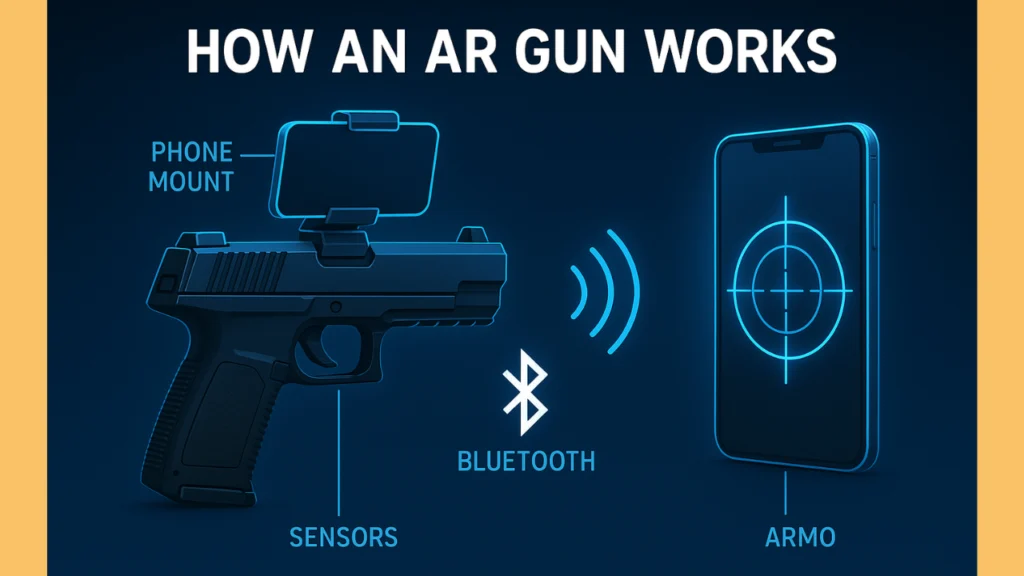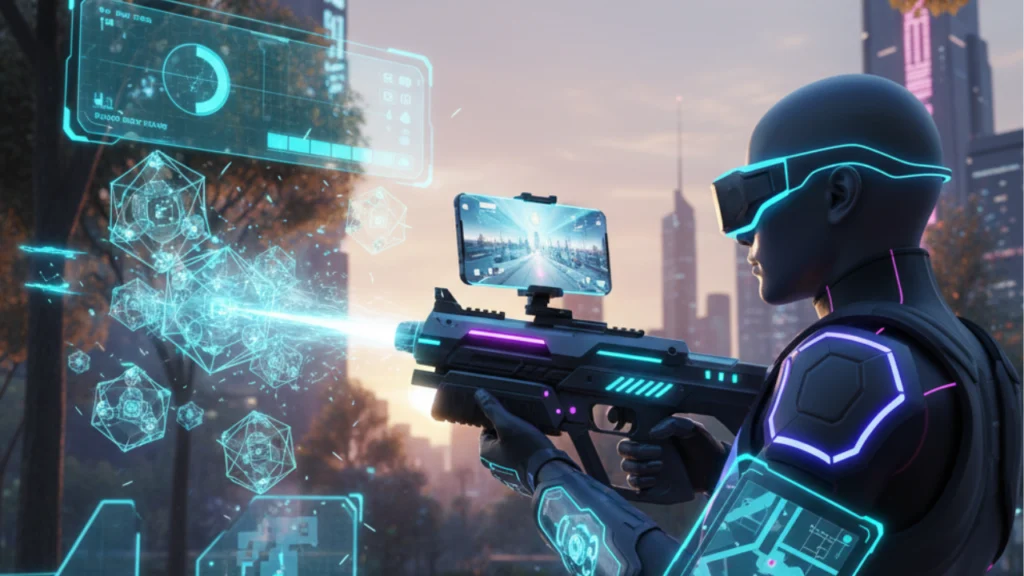Imagine pointing a sleek controller at your living room wall, and suddenly virtual targets pop up, you pull the trigger, and boom, you’ve landed the shot. That’s the heart of the augmented reality gun concept. In this article, we’ll explore the tech behind this exciting device, how it works, what games and markets are driving it, and what lies ahead for both fun and serious use.
The term “Augmented Reality Gun” refers to a specialized controller or device that enables a user to engage in an AR shooting game or immersive experience where virtual and real-world elements integrate. From a gaming perspective, it’s about an AR gun controller offering a highly immersive shooting experience. But as we’ll see, the concept goes way beyond just games.
How Augmented Reality Gun Work

Sensors, Bluetooth & Mobile Apps
An augmented reality gun uses a combination of sensors, wireless connectivity, and apps or platforms to detect your movement, aim, and trigger pull, and then maps that into a virtual layer over your real environment.
Key Components of Augmented Reality Gun
- Motion / position sensors
Many devices include gyroscopes, accelerometers, or infrared/optical markers.
For example, the research paper AR‐Ghost Hunter, an augmented reality gun application, describes using infrared markers and pose estimation to enable the “AR gun” device to operate in a real environment. - Bluetooth / wireless connection
A typical AR gun connects to a smartphone or tablet app via Bluetooth. One product described as a Bluetooth Game Gun with Cell Phone shows exactly this setup. - Mobile app + camera feed
The smartphone or tablet acts as the “window” into augmented reality, using its camera to capture the real world and overlay virtual targets or enemies. - Trigger & haptics
The controller has a trigger, and sometimes vibration or haptic feedback to simulate recoil or shot impact. - Calibration and alignment
The system must align the physical aiming direction with the virtual target location (pose estimation, tracking). The AR-Ghost Hunter paper delves into that technical challenge.
Typical Workflow User Guide
- Clip your phone into the gun controller bracket.
- Launch the AR app and grant camera/motion access.
- Calibrate your aim, sometimes aligning a marker or tapping to set the zero-point.
- Use the gun controller to aim at your real-world scene; the camera overlays virtual enemies or targets.
- Pull the trigger; Bluetooth sends the signal; app registers hit/miss; statistics and score update.
- Move physically (walk around, duck, lean), and the mixed-reality gun gameplay adjusts virtual targets to stay anchored in real space.

Why does this matter for an immersive shooting experience?
Because your physical movement, the real world, and virtual objects are all combined, an immersive shooting experience occurs. You’re not just sitting and pressing buttons; you’re moving, aiming, interacting with your space. That’s the core of mixed-reality gun gameplay.
Popular AR Shooting Games & Devices
Let’s look at what’s available now or recently in the world of augmented reality weapons and Augmented Reality gun controllers.
- A review of “Augmented Reality Gaming System ‘’AR Gun” describes a Bluetooth-enabled gun that works with a mobile game app.
- Many generic “AR game gun controllers” exist (e.g., the product listing “AR Games Gun Bluetooth Game APP Portable Virtual Gaming Gun Controller” shows mass-production devices aimed at mobile AR shooting games).
- On the research side, “AR-Ghost Hunter” is a notable example of an AR shooting game system that uses specialized hardware and markers.
- In the training/simulation domain, studies show potential use of AR/VR shooting systems for military personnel, illustrating crossover between gaming and training. ijtech.eng.ui.ac.id+1
What you can expect from these devices
- They’ll typically support mobile phones or tablets (iOS/Android) rather than full high-end headsets.
- The “gun” controller may look loosely like a toy gun or a bracket-plus-trigger setup.
- Games will overlay virtual targets on real-world backgrounds (your room, backyard, etc.), blending indoor/outdoor spaces.
- Scores, leaderboards, and competitive gameplay are often built in, especially for AR shooting games.
- The feel is more immersive than just tapping a screen, but less immersive than full VR with a head-mounted display.
Why they’re interesting
Augmented reality weapons (in a gaming context) add a layer of physical activity, spatial awareness, and real-world interaction to the gameplay. For younger players or seasoned gamers, an “AR gun” can bring a fresh, more active twist to shooting games.
AR Gun vs VR Gun: What’s the Difference?
Quick Answer
- A VR gun is used within a fully immersive virtual reality system (you’re in a headset, the real world is hidden).
- An augmented reality gun overlays virtual content onto your real world: you see your actual surroundings and digital targets together.
Table of Key Differences
| Feature | Augmented Reality Gun | Virtual Reality Gun |
| Real world visibility | Yes — you see your room/environment | No — full immersion in virtual world |
| Equipment required | Phone/tablet + controller (or smart glasses) | VR headset + motion controllers |
| Movement type | Mixed reality: physical + virtual | Full virtual movement |
| Interaction with real objects | Possible — you might move around your actual space | Usually limited to virtual room boundaries |
| Sense of immersion | High, but real environment included | Very high — entire scene virtualized |
| Use cases (beyond gaming) | Training, simulation, spatial overlays | Training, full virtual scenarios |
Why Choose One Over the Other?
If you want to stay connected to your physical surroundings (walk around your backyard, dodge real obstacles, play in your home), then an AR gun is a solid pick. If you have a dedicated VR space, want full immersion, and don’t mind blocking out the external world, then a VR gun works.
Using an augmented reality gun, you get the best of both worlds, the real and the virtual, whereas a VR gun pushes you entirely into the virtual. That real-virtual integration is key to mixed-reality gun gameplay.
Real-World Applications Beyond Gaming

While most users think of gaming when they hear “AR gun”, the technology is increasingly used in serious fields like Military, Education, Entertainment
Military & Training
Studies show that AR (and VR) shooting games/simulators can replicate real-world training environments. For instance, the study titled “Exploring the possibilities of using augmented reality for military training” shows strong potential for AR systems among military personnel. DIVA Portal+1
Even though it doesn’t always mention a physical “gun” controller, the same principle of using AR to overlay virtual threats in real environments is in play.
Education & Firearms Safety
One paper titled “Implementation of Augmented Reality as an Interactive Medium for Firearms Education” found that AR allowed learners to explore firearm components and operating procedures without exposure to real-world risk. ResearchGate
Here, an augmented reality gun system (or equivalent) helps teach students about shooting, etc, in a safer way.
Entertainment & Events
Theme parks, laser tag arenas, and immersive escape rooms are beginning to integrate AR gun controllers for experiences that combine physical props, real rooms, and augmented targets. The benefit: you walk around a real set, point an AR gun, and targets/ghosts appear on your screen.
The immersive shooting experience is not just about bullets; it’s about spatial awareness, movement, and integrating the virtual and real worlds.
Future of AR Guns and Emerging Technologies
The horizon for augmented reality guns is rich with possibilities—and a few major challenges.
What’s Coming
- Advanced tracking & haptics: More realistic recoil, weight, texture in the gun controller (see haptics research for VR/AR controllers). Microsoft+1
- Mixed reality headsets, gun controllers: Combine controllers with AR glasses/headsets for a full “live ammo” feel, but using virtual bullets.
- Persistent multiplayer AR gaming: Real-world outdoor arenas where dozens of players carry AR guns and engage in mixed reality competitions.
- Cross-platform integration: AR guns that sync with smartphones, tablets, smart glasses, and other IoT devices for richer gameplay and data tracking.
- Training & simulation growth: As AR maturity grows, more militaries, law enforcement, and security firms adopt AR gun-style controllers for training without live fire.
- Safety & regulatory frameworks: As AR guns become more realistic, guidelines for safe use, licensing, and public spaces will evolve.
Challenges to Address
- Accuracy of tracking in varied lighting/space conditions.
- Calibration and alignment between the physical gun’s aim and the virtual target are critical for a seamless, immersive experience.
- Safety concerns (both physical, unexpected tripping and aiming at people, and psychological, increased realism).
- Cost vs. accessibility: making high-quality AR gun systems affordable for the mass market.
- Ethical and regulatory concerns around “augmented reality weapons”, even in a gaming context, are ensuring they are safe and distinguishable from real firearms.
The term augmented reality gun may evoke futuristic or even sci-fi images, but the technology is already here. As AR hardware improves and software ecosystems mature, the device will move from novelty to mainstream, covering AR gun controller systems in living rooms, training facilities, education centres, and beyond.
Conclusion
In summary, the augmented reality gun is more than just a fancy gaming accessory. It’s a controller built for AR shooting games, leveraging AR gaming technology, sensors, and wireless connectivity to deliver an immersive shooting experience that blends the virtual and the real. We’ve explored how these devices work, contrasted them with VR guns, looked at popular games/devices, and outlined serious applications beyond gaming, such as military training and education. And we’ve peeked ahead at what the future holds, including better haptics, multiplayer mixed-reality arenas, and broader adoption.
Whether you’re a gamer seeking the next leap in interaction, a trainer looking for more realistic simulation tools, or simply curious about tech, understanding the augmented reality gun gives you a window into how AR is reshaping how we play, train, and experience digital content. If you pick one up or try it out, you’re not just playing a game, you’re stepping into a new fusion of worlds.
FAQ
Are augmented reality gun safe to use?
Generally, yes when used in a controlled environment with proper warnings and supervision. Because the device uses virtual bullets overlaid on real surroundings, safety depends on having enough room, avoiding fragile objects, and not aiming at actual people or pets. Some educational AR firearms systems exist precisely to reduce risk.
What devices support Augmented Reality gun games?
Most AR gun controllers support smartphones or tablets (iOS/Android) via apps and Bluetooth. Some may also support AR glasses or mixed-reality headsets, but these are less common in consumer setups right now. For example, mobile “AR gaming gun controller” listings show compatibility with phones.
How does Bluetooth connect with Augmented Reality gun?
The Bluetooth link lets the gun-controller send input (trigger pulls, aim orientation, motion) to the AR app on your mobile device. The app then uses the phone’s camera and sensors to map that input into the game. It’s the wireless bridge between your physical motion and the virtual response.
Can AR guns be used for military simulation?
Yes, they are increasingly used for training and simulation. Research shows AR systems are used in military training contexts for situational awareness and shooter performance. While they may not use the exact same consumer “AR gun controller” as your living-room game, the principle is very similar.


